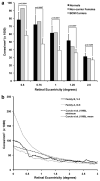Deletion of the X-linked opsin gene array locus control region (LCR) results in disruption of the cone mosaic
- PMID: 20638402
- PMCID: PMC3005209
- DOI: 10.1016/j.visres.2010.07.009
Deletion of the X-linked opsin gene array locus control region (LCR) results in disruption of the cone mosaic
Abstract
Blue cone monochromacy (BCM) is an X-linked condition in which long- (L) and middle- (M) wavelength-sensitive cone function is absent. Due to the X-linked nature of the condition, female carriers are spared from a full manifestation of the associated defects but can show visual symptoms, including abnormal cone electroretinograms. Here we imaged the cone mosaic in four females carrying an L/M array with deletion of the locus control region, resulting in an absence of L/M opsin gene expression (effectively acting as a cone opsin knockout). On average, they had cone mosaics with reduced density and disrupted organization compared to normal trichromats. This suggests that the absence of opsin in a subset of cones results in their early degeneration, with X-inactivation the likely mechanism underlying phenotypic variability in BCM carriers.
Copyright 2010 Elsevier Ltd. All rights reserved.
Figures







References
-
- Ayyagari R, Kakuk LE, Bingham EL, Szczesny JJ, Kemp JA, Toda Y, Felius J, Sieving PA. Spectrum of color gene deletions and phenotype in patients with blue cone monochromacy. Human Genetics. 2000;107:75–82. - PubMed
-
- Ayyagari R, Kakuk LE, Coats CL, Bingham EL, Toda Y, Felius J, Sieving PA. Bilateral macular atrophy in blue cone monochromacy (BCM) with loss of the locus control region (LCR) and part of the red pigment gene. Molecular Vision. 1999a;5:13–18. - PubMed
-
- Ayyagari R, Kakuk LE, Toda Y, Coats CL, Bingham EL, Szczesny JJ, Felius J, Sieving PA. Blue cone monochromacy: Macular degeneration in individuals with cone specific gene loss. In: Hollyfield JG, Anderson RE, LaVail MM, editors. Retinal Degenerative Diseases and Experimental Therapy. New York: Kluwer Academic/Plenum Publishers; 1999b.
-
- Berson EL, Sandberg MA, Maguire A, Bromley WC, Roderick TH. Electroretinograms in carriers of blue cone monochromatism. American Journal of Ophthalmology. 1986;102(2):254–261. - PubMed
Publication types
MeSH terms
Substances
Grants and funding
- R01 EY009303/EY/NEI NIH HHS/United States
- F32 EY014749/EY/NEI NIH HHS/United States
- P30 EY001319/EY/NEI NIH HHS/United States
- R01 EY004367/EY/NEI NIH HHS/United States
- R01-EY004367/EY/NEI NIH HHS/United States
- R01 EY009620/EY/NEI NIH HHS/United States
- R01-EY014375/EY/NEI NIH HHS/United States
- R01 EY014375/EY/NEI NIH HHS/United States
- P30-EY001319/EY/NEI NIH HHS/United States
- P30 EY001730/EY/NEI NIH HHS/United States
- R01-EY017607/EY/NEI NIH HHS/United States
- P30-EY001931/EY/NEI NIH HHS/United States
- R01-EY009620/EY/NEI NIH HHS/United States
- F32-EY014749/EY/NEI NIH HHS/United States
- R01 EY017607/EY/NEI NIH HHS/United States
- P30 EY001931/EY/NEI NIH HHS/United States
- R01-EY009303/EY/NEI NIH HHS/United States
LinkOut - more resources
Full Text Sources
Other Literature Sources
Medical
Research Materials

